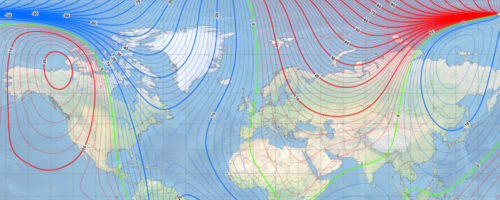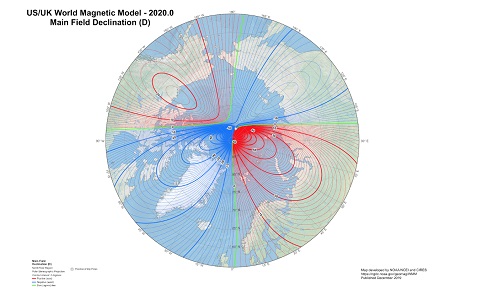The latest report from the National Oceanic and Atmospheric Administration (NOAA) shows the earth’s northern magnetic pole shifting toward Russia at an nearly unprecedented rate.

In fact, the magnetic north pole crossed the prime meridian just a few days ago. (A prime meridian is the meridian (a line of longitude) in a geographic coordinate system at which longitude is defined to be 0°. Together, a prime meridian and its anti-meridian (the 180th meridian in a 360°-system) form a great circle. This great circle divides Earth into two hemispheres. If one uses directions of East and West from a defined prime meridian, then they can be called the Eastern Hemisphere and the Western Hemisphere.)

Since Earth’s magnetic field is created by its moving, molten iron core, its poles aren’t stationary and they wander independently of each other. Since its first formal discovery in 1831, the north magnetic pole has traveled around 1,400 miles (2,250 km). This wandering has been generally quite slow, allowing scientists to keep track of its position fairly easily. Since the turn of the century, this speed has increased.
The latest five-year model called the WMM2020 forecasts that the northern magnetic pole will continue drifting toward Russia, although at a slowly decreasing speed—down to about 40 km per year compared to the average speed of 55 km over the past twenty years.
The military uses the WMM for undersea and aircraft navigation, parachute deployment, and more. Other governmental organizations, such as NASA, the Federal Aviation Administration, U.S. Forest Service, and many more use the technology for surveying and mapping, satellite/antenna tracking, and air traffic management.
More than anything, the shift of the Magnetic North Pole affects navigation systems containing magnetic compasses. While modern smartphones, vehicles, ships, and airliners are connected to satellite-based navigation systems, like GPS and GLONASS, their receivers don’t provide a sense of direction, rather, only a person or vehicle’s fixed location.
As a result, navigation systems’ magnetic compasses, or magnetometers, are used to provide an accurate estimate of the direction a phone, vehicle, ship or plane is pointing in using what’s known as declination – the difference between true north and the direction of the compass. If the mathematically expected location of the Magnetic North Pole is wrong, navigation equipment will be off kilter.
For this reason, the recently announced update to the World Magnetic Model, the mathematical foundation for navigation which allows magnetic north to be precisely fixed, is crucial, and could not have come a moment too soon.
How will it affect us?
Accounting for the shift in the pole’s location is particularly important in areas above the 55th parallel, which covers northern Canada, Scandanavia, and much of Russia.
For most civilian purposes in Western Europe and North America, British Geological Survey geophysicist Ciaran Beggan says the changes would be relatively minor. “The average user is not going to be overly affected by this unless they happen to be trekking around the high Arctic,” he told National Geographic.
However, militaries, commercial airlines, search and rescue ships and aircraft, NASA, and other agencies and groups relying on precision navigation in the high north should find the update helpful.
Airport runways are perhaps the most visible example of a navigation aid updated to match shifts in Earth’s magnetic field. Airports around the country use the data to give runways numerical names, which pilots refer to on the ground.
“The declination has changed just over 2.5 degrees over the past 22 years since Denver opened,” Heath Montgomery, the international airport’s former spokesperson, said after a previous WMM update.
The rapid change in the location of magnetic north has scientists concerned about a flip-flop in the earth’s magnetic field.
The last flip-flop occurred roughly 780,000 years ago and is accompanied by a weakening of the magnetic field that surround the Earth and protects the planet from harmful cosmic rays.
Most scientists believe a flip-flop is not imminent nor do they believe such an occurrence would happen very quickly.
However, the rapid shifts in the magnetic field along with the changes in the earth’s core which cause those changes are not well known and the effects could be far beyond what current scientist imagine.